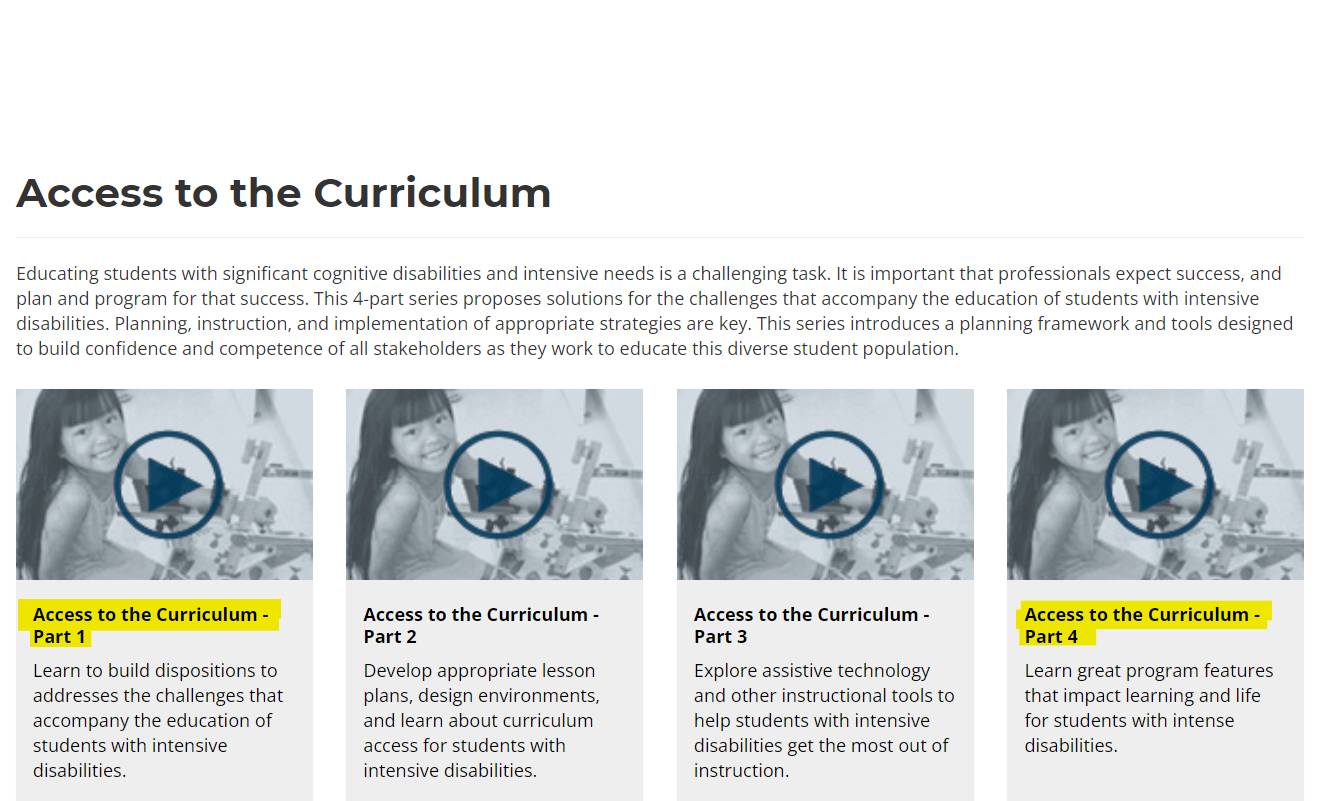Navigation
Empowering Students Introduction
Key Elements
- Supported Decision Making
- ► Maintaining High Expectations
- Making Informed Choices
- Person-Centered Planning
- Social Emotional Learning
Resources: Empowering Students
Maintaining high expectations both at school and home is a predictor of improved outcomes after high school. Research demonstrates holding young adults to low expectations is a barrier to career and postsecondary education success. For families, this involves having expectations of taking part in home chores, taking increased responsibility for self care such as making appointments, doing laundry, and leading the conversation at doctor’s appointments. Young adults acquire these skills over time by learning to do more and take on additional responsibility. This is important upon leaving high school, and being more prepared as an independent adult. There are ways to increase expectations including creating a school-wide culture of higher expectations, assuring students can access college and job readiness tools and more rigorous coursework, ensuring specialized instruction that is needed, setting challenging academic goals, and ensuring progress in the general education curriculum (Carter 2014; Report of the Advisory Commission, 2011; USDE, 2020).
OCALI: Competitive, Integrated Employment is the Expectation for All Youth with Disabilities
OCALI: Competitive, Integrated Employment is the Expectation for All Youth with Disabilities: Maintaining high expectations by families, educators, and others interacting with students is extremely important. When we expect success, there is a greater likelihood students will be successful. It is essential to maintain an expectation of competitive integrated employment (CIE) into adulthood and focusing activities on services and supports which promote more productive employment outcomes. While there may be challenges with obtaining and maintaining employment due to characteristics related to autism such as theory of mind, sensory, and executive function, with accommodations and training individuals with autismcan often develop skills needed to navigate social and job-related requirements. It is important transition teams identify transition assessments which support the needs of individuals with autism, cultivate strengths and interests which match potential jobs, and educate those supporting individuals with autism to assure appropriate support and understanding of needs for promoting success.
Transition Youth and Employment: Transition to adulthood in Michigan officially at 16 years in Michigan, but planning can start earlier. The following core principles are provided by OCALI when planning for competitive integrated employment.
- Core Principle 1: Competitive, integrated employment is the expectation for all youth with disabilities.
- Core Principle 2: Transition planning for youth requires multi-agency collaboration.
- Core Principle 3: Early dialogue with individuals and families is critical to ensuring employment outcomes.
- Core Principle 4: There are multiple pathways to employment.
- Core Principle 5: Person-Centered planning is key to the development of effective services and supports for transition-age youth.
Related Learning Activities:
- Review the Core Principle 1: Competitive, Integrated Employment is the Expectation for all Youth with Disabilities.
- Watch the Ohio Employment First: Changing Expectations video (8:21).
OCALI: Accessing the Curriculum
OCALI: Access to the Curriculum Students with intensive disabilities have limitless potential. To ensure that all students attain their personal goals, we work toward developing the disposition or attitude in all educators that every student is a valuable, contributing member of the learning community. This first segment introduces individuals with intensive needs and shares their stories. It discusses the unlimited options for their future and promotes the messages of ownership, high expectations, advocacy, and the importance of providing appropriate opportunities to encourage success.
Related Learning Activities:
OCALI: Ensuring Access to the General Curriculum for All Learners - Review the chapters and content below and access relevant information. Each chapter provides modules, content, examples, and resources, related to accessing the general education curriculum:
- Chapter 1 Ensuring Inclusive Dispositions and Presuming Competence
- Educator dispositions are made up of personal values, commitment to specific causes, and ethics for the teaching profession that influence their attitudes, choices, and daily interactions with learners, their families, and colleagues. Dispositions inadvertently affect how we prepare, interact with, engage, and motivate each learner, and how we view our own need for professional development as educators. In this chapter, we hope to promote inclusive mindsets, and the belief that ALL individuals can participate in and learn challenging content to improve their knowledge and skills
- Chapter 2: Design Rich Tier I Core Instruction and Assessment
- Planning for instruction is one of the most critical actions educators can take to ensure that ALL learners are provided with meaningful, accessible, and grade-appropriate instruction. Unfortunately, research also shows that many learners with disabilities do not receive full access to the general curriculum. With the right guidance and supports, educators can reshape planning practices. Access to Tier I instruction and assessment, paired with Specially Designed Instruction (SDI) and/or intervention, has the power to fill gaps in knowledge and skills leading to better long-term planning and future outcomes.
- Chapter 3: Designing Inclusive Learning Environments and Rich Tier I Instruction and Assessment
- Inclusive learning requires more than just sharing air and physical space. Inclusive learning can only be provided when diverse learners can come together through collaborative planning that develops meaningful and accessible content and materials and at the same time integrates individual supports and services. When we work together to provide meaningful access to the general education curriculum learners, their families, educators, and communities all benefit.
- Chapter 4: Language and Communication Access: ALL In!
- The Communication Discovery Process outlines steps and resources to help educational teams identify individuals' expressive communication modes and develop multi-modal communication access to ensure that each learner can be heard and understood by those around them. When we explore communication access using a variety of features and options, understandable, expressive communication becomes a reality for ALL individuals.
- Chapter 5: Reading Research in Language and Literacy: From Research to Practice
- Literacy skills among learners of all ages and grade levels across the state and nation are under a microscope. The rate of reading achievement nationally in 2019 on the NAEP assessments in grades 4, 8, and 12 indicates that approximately 34% of students read proficiently at their grade level. As outcome data such as this becomes more readily available at the local, state, and national levels, literacy instruction leading to these data will face scrutiny. Decades of reading research, also known as the Science of Reading, brings together thousands of research studies from across disciplines that outline how individuals learn to read and what might be happening when they don’t. The Science of Reading research also identifies what kind of instruction is most likely to achieve reading success for most learners. The instructional elements outlined in this research should be seen as evidence-based practices and looked for within instruction for all students and in any program selected to teach reading.
- Chapter 6: Word Recognition with Stretch: Access for ALL Learners
- The first step in learning how to read is cracking the code of sounds and symbols. In the English language, there are 44 phonemes, however, there are many more letter patterns representing those 44 sounds. This is where decoding for reading and encoding for writing gets tricky. Explicit instruction in word recognition is required to develop skills such as phonological awareness, orthography, and phonics. For some learners, the sound-spelling code is also critical to access full communication.
- Chapter 7: Language Comprehension with Stretch: Access for ALL Learners
- Once learners have cracked the sound-symbol code for reading and writing, they can apply those skills to access information across all subjects and grade levels, as well as future use across the lifespan. Word recognition skills open doors to new vocabulary that helps build background knowledge. Knowledge of new words in the context of different genres, including literature and informational text, builds comprehension skills. All of this new information can be utilized to complete projects, innovate, and gain and share information with the world.
- Chapter 8: Tier I Continued: A Focus on Standards Aligned and Accessible Lesson Planning
- In Chapter 2, planning began with the selection and organization of standards that can be used to ensure grade-level instruction for ALL learners. Planning continues as standards-based units become individual lessons that integrate the supports and services that provide access features for ALL to participate, learn, and show what they know.
- Chapter 9: Targeted Interventions Tiers 2 and 3
- With Tier 1 instruction and assessment designed and planned out in detail with the integration of individualized supports, services, technologies, and social/emotional/behavioral considerations in place, teams have prepared for all learners, as much as possible. However, even with the best-laid plans, some learners may need more. Outcome data from instruction and screening data may reveal that individual learners may need added layers of reinstruction, specially designed instruction, targeted gap closure, and repeated practice before mastery. Leveraging a team-based Multi-Tiered System of Support (MTSS) can provide these added layers to ensure success at each grade level.
- Chapter 10: Curriculum Screening, Audit, Selection, and Deselection
- The Individuals with Disabilities Education Act (IDEA) requires access to the general education curriculum for individuals with disabilities as part of a Free and Appropriate Public Education (FAPE). The process for screening or auditing curricular tools and resources determines if they are aligned with grade level standards, aligned with language and literacy research/evidence-based practices and if they provide flexible features that promote and value ALL learner access to grade-level content. Curriculum audit tools will be provided as supplementary resources.
ASK Resource Center
ASK Resource Center: ASK is a family-focused nonprofit organization whose mission is to empower individuals with disabilities and their family members by providing innovative and collaborative advocacy, training, resources and supports. Its vision is access, empowerment and acceptance for all.
Related Learning Activities:
- Watch the From Disabilities to Possibilities-The Power of High Expectations video (31:09). This video covers the importance of setting and maintaining high expectations, exploring possibilities, using effective advocacy skills, and creating a team commitment.
- Write down five takeaways from the video.
Family Engagement
Educators and families maintaining high expectations is essential to improved outcomes for autistic young adults. Research supports the importance of maintaining high expectations which can cross settings in school, home, and the community. Families may need guidance in this area, and reassurance of having high expectations is necessary for gaining confidence, growing self-advocacy, obtaining employment, and achieving greater independence.
- Making the Most Out of Transition: A Brief for Families: This brief is intended for families and caregivers to re-imagine the transition years and emphasizing the idea of a “good life,” using a strength-based approach to planning for life after leaving high school.
- Center for Parent Information and Resources: Self-Advocacy Skills Building
- Transition Tennessee/Tennessee Works: Wilson Family - Holding High Expectations (video) (2:59)
- START iQuest
Navigation
Empowering Students Introduction
Key Elements
- Supported Decision Making
- ► Maintaining High Expectations
- Making Informed Choices
- Person-Centered Planning
- Social Emotional Learning
Resources: Empowering Students



